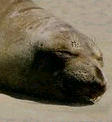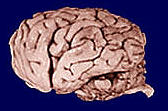|
July 23, 2001
 Animals that live in the water cannot depend on their eyes to find food
and avoid objects. These animals need to use other sensory
abilities because
their environment is often dark and cloudy. Fish have a lateral
line system to sense small changes in water pressure, and dolphins use
echolocation to find their way. Sharks can detect small electrical
signals in the water to find prey. New research provides clues to how
seals navigate and find food: they use their whiskers!
Animals that live in the water cannot depend on their eyes to find food
and avoid objects. These animals need to use other sensory
abilities because
their environment is often dark and cloudy. Fish have a lateral
line system to sense small changes in water pressure, and dolphins use
echolocation to find their way. Sharks can detect small electrical
signals in the water to find prey. New research provides clues to how
seals navigate and find food: they use their whiskers!
 When fish swim, they disturb the water and leave a wake behind.
Scientists at the University of Bonn and Ruhr University Bochum in Germany
wanted to know if harbor seals could detect this underwater wake.
Instead of using fish, the scientists used a small submarine to create an
underwater trail and trained two harbor seals to chase it. After the
seals learned to find the sub, they were outfitted with headphones to
eliminate sound and blindfolded to eliminate light. After the sub was
launched, its motor was turned off and the seals' headphones were removed.
The blindfolded seals then had to find the sub.
When fish swim, they disturb the water and leave a wake behind.
Scientists at the University of Bonn and Ruhr University Bochum in Germany
wanted to know if harbor seals could detect this underwater wake.
Instead of using fish, the scientists used a small submarine to create an
underwater trail and trained two harbor seals to chase it. After the
seals learned to find the sub, they were outfitted with headphones to
eliminate sound and blindfolded to eliminate light. After the sub was
launched, its motor was turned off and the seals' headphones were removed.
The blindfolded seals then had to find the sub.
 When a seal began its search, it extended its whiskers (called
"vibrissae") to their most forward position. The seal also moved its head
back and forth slightly. When the seal intersected the sub's water trail,
it followed the sub. The seals found the sub in approximately 80% of the
trials. When the seals failed to find the sub, it was most often because
they never found the trail, not because they went off course.
Furthermore, when the seals wore a stocking mask that covered their
vibrissae, they were never able to locate the sub.
When a seal began its search, it extended its whiskers (called
"vibrissae") to their most forward position. The seal also moved its head
back and forth slightly. When the seal intersected the sub's water trail,
it followed the sub. The seals found the sub in approximately 80% of the
trials. When the seals failed to find the sub, it was most often because
they never found the trail, not because they went off course.
Furthermore, when the seals wore a stocking mask that covered their
vibrissae, they were never able to locate the sub.
 A
final experiment investigated how the seals located the sub when it
changed course. If the seals used sound to locate the sub, they should
have taken short cuts to go directly to the sub after it made a course
change (see figure on the left). However, the seals did not take any
shortcuts. Rather, they followed the entire course of the sub and turned
where the sub turned. A
final experiment investigated how the seals located the sub when it
changed course. If the seals used sound to locate the sub, they should
have taken short cuts to go directly to the sub after it made a course
change (see figure on the left). However, the seals did not take any
shortcuts. Rather, they followed the entire course of the sub and turned
where the sub turned. |



![[email]](./gif/menue.gif)




